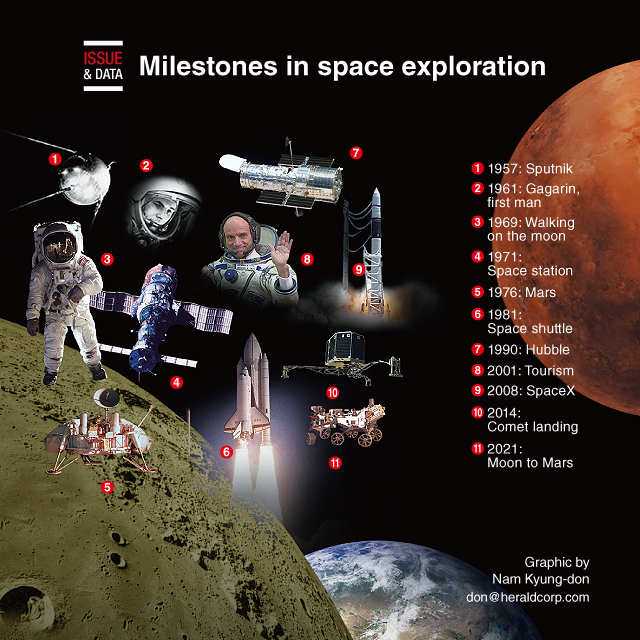 The era of space tourism is on the horizon 60 years after Soviet cosmonaut Yuri Gagarin became the first person in space.
The era of space tourism is on the horizon 60 years after Soviet cosmonaut Yuri Gagarin became the first person in space.
From Yuri Gagarin to the first man on the moon and the robot that landed on a comet, we look at 10 key dates in space exploration. (AFP)
1. 1957: Sputnik
Moscow launches the first satellite, Sputnik 1, Oct. 4, 1957, ushering in the Cold War tussle for the cosmos.
The beach ball-sized aluminum sphere takes 98 minutes to orbit the Earth and sends back the first message from space, simple “beep-beep-beep” radio signals.
A month later Sputnik 2 carries the first living being to fully orbit the Earth, a small street dog called Laika. She dies after a few hours.
2. 1961: Gagarin, first man
On April 12, 1961, Soviet cosmonaut Yuri Gagarin becomes the first man in space, completing a single, 108-minute orbit aboard Vostok-1.
Twenty-three days later Alan Shepard becomes the first American in space when he makes a 15-minute trip.
On June 16, 1963, cosmonaut Valentina Tereshkova becomes the first woman in space.
It takes a full 40 years for the old Cold War rivals to be joined in space by a third country, when China sends up Yang Liwei onboard Earth orbiter Shenzhou 5.
3. 1969: Walking on the moon
US astronaut Neil Armstrong is the first man to step onto the moon on July 21, 1969, Buzz Aldrin joining him around 20 minutes later.
Between 1969 and 1972, 10 astronauts - all American - walked on the moon as part of NASA’s Apollo program.
4. 1971: Space station
The Soviet Union launches the first orbital space station, Salyut 1, on April 19, 1971.
Another Russian space station, Mir, follows. It is brought back to Earth in 2001 after 15 years in orbit.
Construction of the still-operating International Space Station starts in 1998. The biggest manmade structure in space, it orbits Earth 16 times a day.
5. 1976: Mars
US spacecraft Viking 1 becomes the first to successfully land on Mars on July 20, 1976, and sends back images of the red planet.
The robot Opportunity explored Mars between 2004 and 2018, with NASA’s Curiosity Rover still active there.
About 40 missions are sent to Mars, more than half of which fail.
6. 1981: Space shuttle
The US space shuttle Columbia, the first reusable manned spacecraft, makes its first voyage on April 12, 1981.
It is followed by Challenger, Discovery, Atlantis and Endeavour, which serve the International Space Station until the shuttle program winds up in 2011.
The US has since depended on Russia to transport its astronauts to the International Space Station.
Two US shuttles were destroyed in flight, with the loss of 14 astronauts: Challenger in 1986 and Columbia in 2003.
7. 1990: Hubble
Hubble is the first space telescope to be placed into orbit on April 25, 1990, 547 kilometers above the Earth.
It revolutionizes astronomy, allowing scientists to observe the planets and distant stars and galaxies unimpeded.
8. 2001: Tourism
On April 28, 2001, Italian American multimillionaire Dennis Tito, 60, becomes the world’s first space tourist. He pays Russia $20 million to stay on the International Space Station for eight days.
In all, seven space tourists have taken Russian flights to the International Space Station.
The US company SpaceX is planning to launch its first space tourism mission at the end of 2021.
9. 2008: SpaceX
SpaceX becomes the first private firm to successfully launch a rocket into the Earth’s orbit in September 2008.
Its Dragon cargo ship becomes the first commercial spacecraft to visit the International Space Station in May 2012, on a mission for NASA.
Since then, SpaceX has conquered the satellite launch market with its Falcon 9.
After flights in 2020, SpaceX has planned two other manned launches for NASA to the International Space Station in 2021, including one that will lift off from Florida on April 22 with French, American and Japanese astronauts.
10. 2014: Comet landing
The European Space Agency places a small robot, Philae, on a comet more than 500 million kilometers from Earth on Nov. 12, 2014. The first comet lander is part of a mission aiming to explore the origins of the solar system.
The manmade object that is furthest away from the Earth is the unmanned US spaceship Voyager 1, launched in 1977 and still traveling.
In August 2012 it made it into interstellar space, about 21 billion kilometers from Earth.
11. 2021: Moon to Mars
NASA sees the moon as a pit stop for missions to Mars. It aims to send the first woman to the moon by 2024.
Perseverance became the fifth rover to set wheels down on Mars on Feb. 18, laying the groundwork for NASA’s first attempt at powered, controlled flight on another planet. (Source: AFP)
Words in this Article
Usher – v. to show someone where they should go, or to make someone go where you want them to go
The cosmos – n. the universe considered as a system with an order and pattern
Astronomy – n. the scientific study of the universe and of objects that exist naturally in space, such as the moon, the sun, planets, and stars
Conquer – v. to take control or possession of foreign land, or a group of people, by force
Interstellar – adj. between the stars
Comprehension Quiz
- What is this article mainly about?
- Who is Yuri Garin?
- In which year did the first man, Neil Armstrong step onto the moon?
- What was the name of the first space telescope and what did it revoluationize?
- What does the word, 'pit stop' mean in the last paragraph(no.11)?